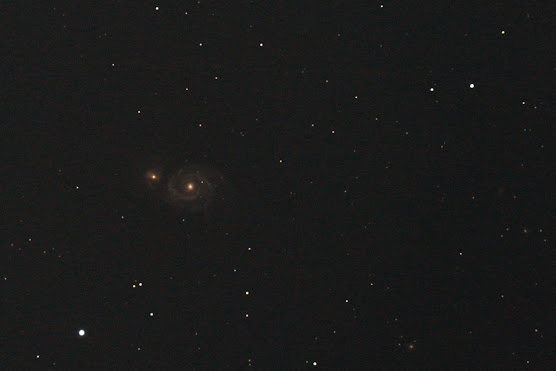On the 2nd April I took an extra frame of Z Ursae Majoris with the intention of attempting some photometry with it. This was the frame:-
This is a single 30s exposure at ISO 800 (taken at 20:44 UT). It looks a bit odd because I have deliberately prevented the brighter stars on it (including Z - marked) from saturating. The stars are also defocused (perhaps by slightly too much) as this will help the photometric measurements. This is actually a binned (x4) jpeg image shown here, but for my measurements I used an uncompressed 16 bit tif.
So how can we go about measuring the magnitude of Z UMa? On the image I have marked three other comparison stars; 84, X and Y. 84 is the star that is referred to on the AAVSO chart X28625AEL (see my previous post). Stars X and Y (my designation) will be referred to below. The method will be to measure the brightness of each of these comparison stars and compare it to the brightness of Z in the green G channel. The green channel is used as this better matches the visual response of our eyes.
Beginning with Z I used Photoshop to open the tif file and place a circular selection around the star of diameter 70 pixels. This was big enough to encompass all the light from the star but not so big as to start adding more light from the background. Using the histogram tool I used the green channel and found that the mean count per pixel was 92.02 over 3852 pixels which gives a total count of 92.02 x 3852 = 354461.04.
I then placed a larger circular selection of 120 pixels diameter centred on the star and measured the green colour count in that. The mean count per pixel in this case was 47.33 over 11304 pixels giving a total count of 47.33 x 11304 = 535018.32. I made sure (by temporarily stretching the image) that this measurement wasn't affected by any hot pixels or background stars. This total count includes light from Z and from the sky background. So the sky background surrounding the star is 535018.32 - 354461.04 = 180557.28. This is spread over an area of pi x (120/2)^2 - pi x (70/2)^2 = pi x 2375 = 7461 pixels. Therefore the mean count per pixel for the sky surrounding Z is 180557.28 / 7461 = 24.20. If we want to obtain the count per pixel that is just due to the star we have to subtract this from what we recorded, namely 92.02 - 24.20 = 67.82 per pixel.
This is the first main measurement. We now repeat this process for the comparison stars. I used exactly the same circular selections of 70 and 120 pixels for each measurement.
Beginning with star 84. This star has another designation HIP58303. This is a Hipparcos catalogue number. According to the AAVSO they assign this star as having a V magnitude of 8.438. I measured the sky background around this star to be 22.45 counts per pixel and the sky subtracted brightness for the star to be 23.27. Unfortunately, the brightness of the star at the position of 84 on the frame will not be quite the same as the brightness of the star at the position of Z due to vignetting (and for other reasons, such as atmospheric extinction). You can see this to a certain extent by the fact that the sky at the position of 84 is fainter than at the position of Z (22.45 vs 24.20, respectively).
We need to make a correction for this. Below is an image which shows the vignetting of this telescope/camera combination:-
You can see that the image is darker at the edges of the frame. To find how to correct the brightnesses, I put a square selection of 100x100 pixels centred at the position of Z and at the position of star 84. The counts per pixel were, respectively, 61.80 and 56.84. This means that the corrected count per pixel for star 84 should be (61.80/56.84) x 23.27 = 25.30.
Now we estimate the magnitude of Z. The difference in magnitudes between Z and star 84 is given by
m (84) - m (Z) = 2.5 log10 (brightness of star Z / brightness of star 84)
which implies
8.438 - m (Z) = 2.5 log10 (67.82/25.30)
and m (Z) = 7.37 (to 2 d.p.).
Now we can make similar calculations for the other comparison stars X and Y.
Star X is HIP57820 (also known as Aniara) and this has a V magnitude of 7.858. The sky brightness at the position of this star is 20.46 per pixel and the sky subtracted count for this star is 36.78. Correcting for vignetting this is 42.01. From this I obtain a magnitude of 7.34 for Z.
Star Y is HIP58302 and has a V magnitude of 8.375. The sky brightness at the position of this star is 19.51 per pixel and
the sky subtracted count for this star is 24.99. Correcting for
vignetting this is 28.73. From this I obtain a magnitude of 7.44 for Z.
So in all we have three estimates for Z of 7.37, 7.34 and 7.44 which gives a mean of 7.38 +/- 0.05. I think these values are pretty consistent considering I am not using software to produce the results. The problem is that I know that Z had a visual magnitude of about 7 on this date (2nd April 2023) and so my value is too faint.
The problem that needs to be addressed, I think, is that the green G channel of my camera (a Nikon D90) is going to respond differently to the eye (and to Johnson V) and this needs to be corrected for. I need to do this calibration and I need to adopt some photometric software to carry out the processing.
All text and images © Duncan Hale-Sutton 2023













